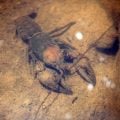How to Tie a Composite Loop Zonker
Producer: Tim Flagler
This fly is called a Composite Loop Zonker because it incorporates a lower body that’s formed with a composite loop. These loops are extremely versatile and offer a whole other dimension to fly tying. I’ve got to thank the guys at OPST for all the great videos illustrating how they’re made.
For a hook, I like a Dai-Riki #730, here, a size 6. This is a fair bit of hook and you want to be sure that your tying vise will hold it securely.
For thread, I’m going to use black UTC 140 Denier. Get your thread started on the hook shank leaving an eye length or so space behind the eye, and take a few wraps rearward before snipping or breaking off the tag.
To prevent the tail of the fly from fouling, I use 30 pound test Maxima Ultragreen. A 10” length is enough to make numerous flies. Lay one end of the mono on top of the hook shank at the tie-in point, and take a few wraps to secure it. Continue taking thread wraps to bind the line to the top of the shank, all the way to the start of the hook bend. Double the line back to form a loop and then take 5 or 6 wraps to loosely hold the loop so you can adjust it to length, something about like this. Snip off the excess mono so it doesn’t get in the way and take thread wraps forward with the two lengths of mono touching on top of the shank. A little bit of Fly Tyer’s Z-Ment brushed over the assembly and then covered with tight thread wraps will help to increase durability. End with your tying thread right at the start of the hook bend.
The back and tail of the fly are formed by a single pine squirrel zonker strip. If you’re only going to get one color, I highly recommend sculpin olive. Cut a single strip free and find the back end where the fur angles rearward. Measure to form a tail a hook shank in length and transfer that measurement rearward to the tie-in point. A little moisture will help to keep the fur separated. Take a couple of really firm wraps of tying thread to bind the strip down on top of the hook shank then pull the remainder back and take a couple of wraps around just the shank. Follow this with a few more over top. Pull the strip back again and take a few wraps up the hook shank to about the 1/3 point.
You can use a piece of paper for the next step but I’ve found a 3×5 post-it pad, because of its height, makes things easier when building a composite loop. To start, I’m going to use SLF Prism Dubbing. Ice dub also works really well. First, I’ll use pearl. Pull a small clump apart several times to roughly align the fibers and then lay these little slips of material down the 3” side of the post-it pad. In addition to color and shimmer, these fibers will help to add some structure.
I like to incorporate Rabbit dubbing because it’s available in a tremendous range of colors and its long fibers are well suited to composite loop construction. I’m going to start with some cream colored. Here, too, I’ll take the clump and pull it apart several times to help align the fibers, and then place each little slip directly on top of the layer below. At the bottom of the loop, you can use some red rabbit fur to kind of look like gills. This end of the loop will be the head of the fly. To enhance structure, another very thin layer of synthetic dubbing works really well. I’ll use a popsicle stick to first mash and kind of meld the layers together and then push the material half way off the edge of the post-it pad. From here you can pick it up with your hand but a chip clip works especially well. With the material secured, set it aside for the moment.
Pull down on your bobbin to expose about 10” of tying thread. Double the thread over and take a wrap around the two legs of the loop to close it down, follow this with a few wraps rearward to keep it that way. Dubbing wax is your friend when it comes to composite loops. I like the Super Sticky Formula from Wapsi. Coat both legs of the loop, then open it wide with your fingers and insert the dubbing material. Squeeze the legs of the loop together as you let go of the clip. With a dubbing spinner, this one’s from OPST and works exceptionally well, insert the hook end into the bottom of the loop and pull your fingers free. At this stage, you can make modest adjustments to the dubbing to even it up or spread it out as needed.
Squeeze the legs of the loop together with the fingertips of your left hand and then give the dubbing spinner a healthy clockwise spin. This will cord up the loop into a frizzy noodle that looks ok, but you’re not done quite yet. Get hold of your bodkin and run it along the thread to pick out any trapped material. Spend some time doing this, it’ll be worth it in the end. Next, you’re going to need a stiff-bristled toothbrush. Use it to further brush out the dubbing so there are no clumps at the thread core.
Wet the fingertips of your left hand and begin folding the fibers over so they’re all on one side, kind of like folding a hackle feather. Advance your tying thread forward to the initial tie-in point and start taking wraps with the composite loop, pulling the fibers rearward as you go. Continue making touching wraps up the hook shank, preening the fibers back in the process. Ideally you should end right at your tying thread and then use it to anchor the loop before snipping the excess off close. It should look something about like this.
Now, use your toothbrush once again to really fluff out all the material. Don’t be afraid to scrub hard, composite loops are remarkably tough. Then, with wet fingertips, preen the material down and back on either side of the hook, Alfalfa-style. Pull the zonker strip forward, straight down the hook shank and out over the eye. Use a little moisture to separate the fur behind the eye and take nice, tight thread wraps to secure the strip. You can then snip the excess off close. Finish up the head of the fly with a few more thread wraps, a 5 or 6 turn whip finish and then snip or cut your tying thread free. A bit of head cement, here Hard as Nails, applied to the thread wraps will ensure the zonker strip won’t pull free and that nothing will come unraveled.
With composite loop construction, the color and body materials you can use are pretty much unlimited. Have at it!
How to Tie a Comparadun
How to Tie a Conehead Bunny Leech











